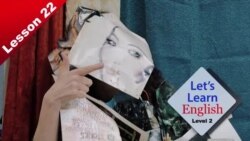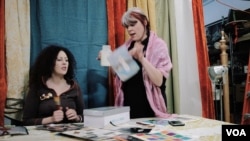Summary
Sue tries to teach Anna how to turn trash into treasure. But Anna doesn't seem to know what treasure is. And she makes a big mess.
Conversation
Sue: Welcome to class, Anna. I can’t wait to see your trash!
Sue: Oh, okay. Alright, it’s a -- it’s a net with a … oh, it’s got a hole in it. Tell me about that.
Anna: This net said to me, “Anna, I used to catch stuff. I don’t anymore. So, use me, Anna.” That’s what it said. It said, “Use me, Anna.”
Sue: Okay. So...it’s a plastic helmet.
Anna: This plastic helmet said, “Anna. Hey, Anna, find me a head.”
Sue: Okay, um...and a broken toy.
Anna: This broken toy … this broken toy said to me – it said, “Anna, help me find fun.” “Help me, Anna” is what it said.
Sue: Anna, this stuff is not saying anything to you or me or anyone. It’s what we like to call in the business … garbage.
Anna: But you said to bring in trash.
Sue: Sometimes trash is treasure. Sometimes it's just trash.
Sue: Anna, don’t worry. Next week, I could teach you decoupage.
Anna: Decoupage. Decoupage. That’s fun to say.
Sue: All you need to bring is a clean shoe box. A box that held shoes.
Anna: I got it. I got it! See you next week!
Prof. Bot: Ut oh. It looks like Anna doesn’t know the difference between treasure and trash. She thinks those things are telling her something!
Prof. Bot: The words tell and say have similar meanings. But we use them in different ways.
Prof Bot: Tell means “to inform or instruct someone with words” and is almost always followed by an indirect object. For example, Sue says, “Tell me about that.”
Prof. Bot: The word me is the indirect object and tells us who is being told.
Prof. Bot: Say means “to express something with words” and focuses more on the words used. For example, Anna says, “That’s what it said. It said, ‘Use me, Anna.’”
Prof. Bot: Listen for when Anna and Sue use tell and say.
Sue: Anna, welcome to Decoupage class. Decoupage is just gluing pretty pictures onto stuff.
(Sue gets a phone call.)
Sue: Anna, I’ve got to talk to this person. I’ll be right back. Don’t start without me.
Anna: Got it.
(Sue leaves to take her phone call. Anna gets glue everywhere. She becomes covered with glue and paper.)
Anna: Okay. I can fix this.
Sue: Anna, what happened? I told you to wait for me!
Anna: Actually, you told me not to start without you, which I didn’t. Your glue is really sticky.
Sue: Next week, let’s try lamp making. There’s – there’s no glue. Here's a flier.
Anna: Thanks. See you next week.
Sue: Anna, you did really well this week. I think lamp making might be your thing!
Anna: Thanks, Sue. I did everything you told me to do.
Sue: Remember: I said to read the instructions really carefully. Where are those instructions?
Anna: Let’s just plug it in!
(Anna plugs in the lamp and, suddenly, the city loses electricity.)
Anna: So, what class will you be teaching next week?
Prof. Bot: Too bad Anna didn’t follow instructions! Visit our website for more on tell and say!
New Words
actually – adv. used to stress that a statement is true especially when it differs in some way from what might have been thought or expected
command – n. an order given to a person to do something
decoupage – n. the art of decorating an object by gluing pictures onto it
electricity – n. a form of energy that is carried through wires and is used to operate machines, lights, etc.
flier – n. a piece of paper that has something printed on it, such as an advertisement
focus – v. to direct your attention or effort at something specific
garbage – n. things that are no longer useful or wanted and that have been thrown out
glue – n. substance used to stick things tightly together
helmet – n. a hard hat that is worn to protect your head
hole - n. an opening in or through something
net – n. a device that is used for catching or holding things or
paper – n. the material that is used in the form of thin sheets for writing or printing on, wrapping things, etc.
picture – n. a painting, drawing, or photograph of someone or something
plastic – n. a light, strong substance that can be made into different shapes and that is used for making many common products
plug – n. a part at the end of an electric cord that has two or three metal pins that connect the cord to a source of electricity
sticky – adj. covered in a substance that things stick to
stuff – n. materials, supplies, or equipment
thing – n. an object whose name is not known or stated
Practice
Now, you try it!
First, read more about tell and say below. Then, practice using those words in the Comments section. Write about what happens in Lesson 22! You can find some examples below. Try making at least one sentence with tell and one with say.
Tell | Say
Tell means “to inform or instruct someone with words.” We use an indirect object (personal pronoun) with tell to say who is receiving the information.
Tell is only used without an indirect object in a few expressions, such as: tell the time, tell the difference and tell the truth.
When we report a command or instruction, we usually also use the verb tell. When we do this, we use an infinitive verb after the indirect object.
|
Command (in Direct Speech) |
Reported Speech |
|
“Read the instructions carefully.” |
She told Anna to read the instructions carefully. |
Use tell:
- In reported speech
- Sometimes in direct speech*
- With a personal pronoun
Examples:
- Sue told Anna that she liked her lamp.
- She told her to read the instructions carefully.
- Anna told her that the broken toys wanted help.
Sue told me, “So…it’s a plastic helmet.”(wrong)
Say means "to express something with words." When we use say, we do not focus on who is receiving the information. So, we do not use an indirect object (personal pronoun).
Use say:
- In direct speech
- In reported speech
- Without a personal pronoun
Examples:
- Anna said the glue was very sticky.
- Sue said that she had to take a call.
- She said, “Don’t start without me.”
Anna said me, “Got it.”(wrong)
|
When to Use |
Tell |
Say |
|
In reported speech |
Yes |
Yes |
|
In direct speech |
Less common |
Yes |
|
With an indirect object |
Yes |
No |
*The verb Tell is sometimes used with direct speech, but this is less common than say. However, it can be common in some types of writing, such as in news reports.
Test Yourself
How well do you know the grammar from Level 2? Test yourself!
In Lesson 22, you will see examples of reported speech and other grammar that you have learned in Level 2. Look for sentences in Lesson 22 with:
- Reported speech
- Past habitual
- Prepositions
- Passive voice
Then, write those sentences in the Comments section. For example: But you said to bring in trash (reported speech).
Listening Quiz
See how well you understand this lesson by taking a listening quiz. Play each short video, then choose the best answer.
Free Materials
Download the VOA Learning English Word Book for a dictionary of the words we use on this website.
For Teachers
Send us an email if you have comments on this course or questions.
Grammar focus: Tell and say
Topics: Making mistakes; Failing and moving on
Comments
Let us know what you think about this lesson. Send us an email or write to us in the Comments section below or on our Facebook page.









